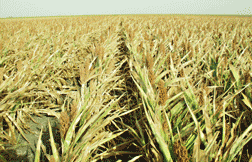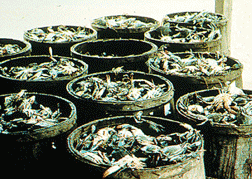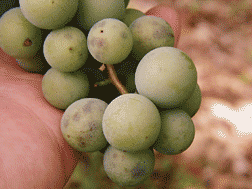Dry as a Bone
From grapes to corn, lawns to tomatoes, well-water to rockfish, we’re all feeling the drought
by Carrie Madren
Under a hazy, blurry, summer sun, Maryland wilts. Grasses have turned to straw, leaves are falling, even weeds have died.
That’s because the atmosphere owes us some five inches of steady rainfall, according to the Department of Natural Resources.
Maryland is parched.
Our 12-hour gentle rain of August 5-6 — which delivered close to an inch in Bay areas — hasn’t quenched our thirst.
Drought is stealing farmers’ crops. It’s withering tomatoes and berries on the vine. It’s drying up wells and sending crabbers commuting all over the Bay for their living. Save for the winemakers who toast the drought, Maryland is dancing for rain.
Our Scorched Piece of Earth
The rain stopped coming early. We emerged from winter already under average by 1.7 inches. Five inches in April put us one-quarter inch ahead of the game. Come May, however, less than one inch of rain gave plants a dry start. It was our fourth-driest May on record, according to the U.S. Geological Survey. June and July have offered only scant passing drizzle.
How deep the drought is depends on where you live. Much of Central and Southern Maryland, including Anne Arundel and Calvert counties, and the Eastern Shore is parched by severe drought; northern and western areas are not as dry but still suffer moderate drought, according to the U.S. Drought Monitor.
Hardest hit are those who live by rain.
A Harvest of Drought
Corn is withering in the fields.
Corn’s roots, growing some five to eight inches deep, depend on long-soaking rains. Grain corn has been especially hard hit. Sweet corn, the corn-on-the-cob kind we chomp at picnics, will often be irrigated for its higher dollar value.
Maryland growers nurture some 450,000 acres of corn and soybeans. “Soybeans are more resilient, and would come back if it rained,” said Sue duPont, Maryland Department of Agriculture spokeswoman.
The loss goes deeper than the fields. Farmers depend on their crops to pay their bills, often borrowing on the expected harvest.
“Maryland’s farmers are having trouble paying their bills due to the drought that has covered the state over the past two months,” said Roger Richardson, secretary of the Maryland Department of Agriculture.
Some counties have reported lost vegetable crops, but most vegetables are irrigated, duPont says. Tomatoes, beans and squash are saved at a cost. “That’s a higher expense for farmers — paying for water and electricity,” she said.
Gov. Martin O’Malley has asked Secretary Mike Johanns of U.S. Department of Agriculture to designate Maryland a drought disaster zone because of the severe dry weather and excessive heat.
“We estimate that farmers in Maryland have lost between 30 and 60 percent of their crop,” said Gov. O’Malley in a statement last week. Disaster designation by the federal government would bring dollars to hard-hit farmers. So far, no designation has been made.
Until financial irrigation flows from D.C., the Maryland Department of Agriculture is offering a bit of relief: free testing of grain for aflatoxins and other drought-encouraged toxins, which are poisonous to livestock. Of course if the test is positive, the crop is lost.
Although Marylanders can still water their lawns, fill their fountains and wash their cars without restriction, home gardeners, too have been waiting for rain.
“If someone hasn’t been irrigating their tomatoes, they will have stopped producing,” reports Bay Gardener Frank Gouin.
For other crops, the dry summer has gone from insult to injury.
“Nectarines are much smaller, and peaches haven’t swelled as much as they usually do, which is also because of the late frost,” Gouin says. “Douglas fir trees usually get a second flush of growth, but now they’re dormant.”
Drought has turned the clock forward for other crops.
“Some chrysanthemums are already in full bloom,” Gouin reports. “They’ll go into shock and go into flower, with very small flowers, way ahead of season.”
Lawns have gone dormant and brown throughout much of the region, too. Grass, however, is like soybeans. Rain, if and when it comes, will revive lawns.

Salty Water
For the Bay, drought, is a mixed blessing.
“The Bay is very dynamic and the critters in it are adapted to these changing salinity patterns,” says Maryland Department of Natural Resources biologist Harley Speir. “It’s a fact of life. There can be enormous swings in salinity from one year to the next, and it’s not necessarily harmful.”
The bad news is hot, oxygen-poor water thickened with algae.
“Typically, less runoff coming into the Bay means less nutrients and sediments,” says Bruce Michael, director of tidewater ecosystem assessment at Maryland Department of Natural Resources. But this year, our recipe of March and April rains followed by a dry summer concocted a mess of trouble. Nutrients from our spring rains were enough to fuel algal blooms all spring and summer.
“We’ve seen higher fish kills in creeks and tributaries because there’s nothing to flush these algal blooms out,” says Michael. “So water clarity has been a lot worse.”
Decreased water clarity combined with repeated heat waves also kill underwater grasses. Eelgrass, which grows in the lower Bay south of the Patuxent and Potomac, dies when temperatures blaze for long periods of time, as in 2005.
Without cooling rains, the water warms, and the warmer the water the less oxygen it holds.
“When it’s hot on the surface,” Michael explains, “fish have to drop down in the water column,” where there’s lower dissolved oxygen. Under those conditions, fish become more susceptible to disease.
This year’s salty Bay makes for an unusual fishing season. Charter boat operators and recreational fishermen report larger numbers of rockfish in the northern Bay, according to DNR’s fisheries biologist Marty Gary.
“The eastern edge — Hooper’s Island to opposite Point Lookout — is known for spectacular fishing, but the rockfish seem to have moved north and seem to be congregating around Calvert Cliffs and Holland Point,” says Gary, who suspects that higher salinity may be leading these stripers north.
Crabbers have seen the changes, too, likely due to our drought’s salty effects.
“Mainstem crabbers tell us that crabs have pushed way north. The upper Bay is doing very well,” Gary says. The middle Bay is more spotty, with “some guys doing okay, other guys not doing too well.” In Maryland’s lower Bay — from the Patuxent to the Potomac — crabbers report poor catches.
In rivers, too, where crabs are caught on trotlines, the crabs are behaving differently. “Trotliners have been telling us that male crabs in rivers have gone into creeks, to find less saline water, where the crabbers can’t even get to them,” Gary says.
There is a bit of good news in this salty brine, Michael predicts: “In the main channel of the Bay, the dead zones should not be as bad this year.” That’s because without rain, fewer nutrients run off from fertilized farms and lawns to feed dead zones.
All’s Not Well
Well users depend on our aquifers to bathe, wash dishes and clothes, drink, cook, water plants and flush toilets. Because groundwater has been pumped to the surface faster than rainfall has replenished it, groundwater levels run low, running shallow wells dry.
“Shallow wells at 20 or 30 feet deep are more at risk,” says Brian Chew, supervisor of well construction and groundwater quality for Anne Arundel County. Last year, says Chew, from May through August, Anne Arundel County issued 53 emergency permits to dig new wells. This year, barely a week into August, he’s already approved 67.
The lower Eastern Shore — where the Manokin aquifer is heavily drawn on for industry and agriculture and Maryland’s largest prison, as well as for homes — has been hardest hit. In Somerset and Wicomico counties on the lower Eastern Shore, 140 wells have gone dry. Southern Anne Arundel — where wells average 150 to 200 feet — has also lost water. In Pasadena, by comparison, wells average 300 to 400 feet.
For those who can’t afford well digging, the county offers a failed sewage and well program with grants based on income. For the two Eastern Shore counties, the state is making grants for new, modern, deep wells.

Some Like it Dry
Dry won’t make for good tomatoes, but it will make for good wine.
“It’s good for us,” says Kevin Atticks, executive director of the Maryland Wineries Association. “Grape vines have very deep roots — 30 to 45 feet deep — and are able to get water they need even in dry long-term droughts.”
For a savory wine, you want a concentrated, small berry with high sugar and little water, Atticks explains, as opposed to store grapes that are big and juicy.
“To be a great wine year,” he continues, “we need rain up front in April and May.” Then in the best years for wine makers, it’s dry through harvest, which begins the first week in September and runs through October.
By those standards, we’ll be toasting this summer’s drought in the future.
“At this point, it’s looking to be a very good year,” Atticks says.
Rain Dancing
Most of Maryland hasn’t entered drought emergency yet, according to the Maryland Department of the Environment. We’re still in the green — which means Normal on the drought scale — except the Eastern Shore, which is in the yellow Watch category. No Maryland county has shriveled to Warning or Emergency status yet.
In the big picture, we’re better off than other states. Maryland’s moderate and severe drought seems bearable compared to the extreme and exceptional drought in southern California and western Arizona, southern Tennessee and northern Alabama, according to the U.S. Drought Monitor.
Up close, we’re thirsty enough. To quench our thirst, according to the Bay Gardener, we need three to four days of steady, soaking rain.
Keep an eye on Maryland in the U.S. Drought Monitor at http://drought.unl.edu/dm/DM_state.htm?MD,NE.
